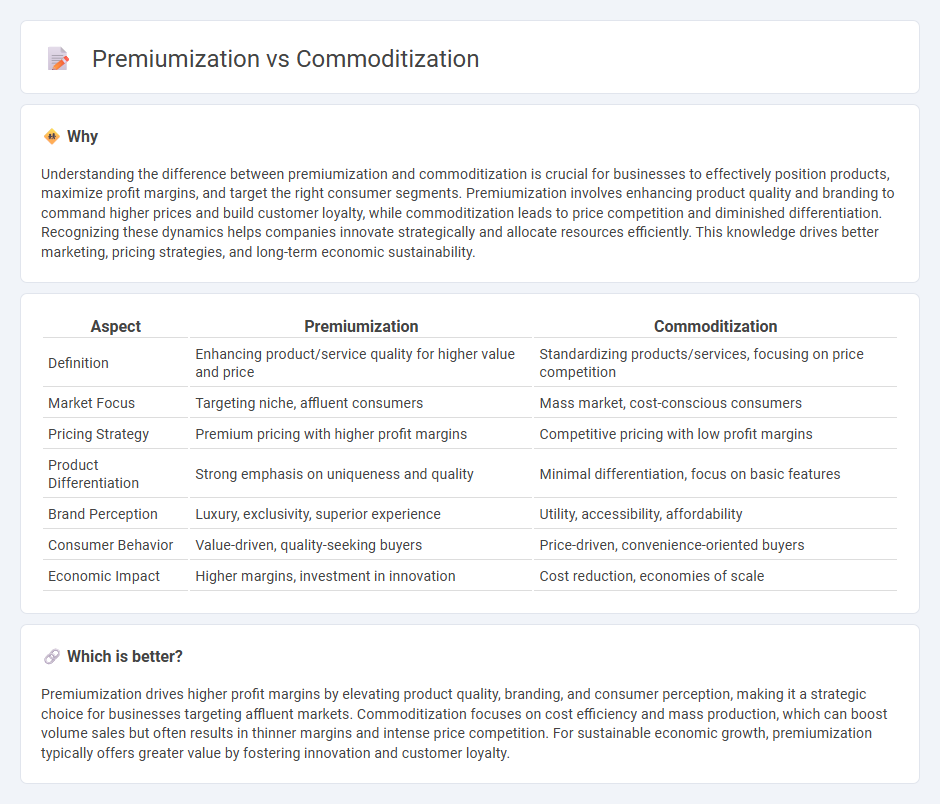
Premiumization drives economic growth by elevating products through enhanced quality, branding, and unique features, appealing to consumers willing to pay higher prices. Commoditization, in contrast, pressures markets with standardized products and intense price competition, often eroding profit margins. Explore how these opposing trends shape market dynamics and consumer behavior for deeper insights.
Why it is important
Understanding the difference between premiumization and commoditization is crucial for businesses to effectively position products, maximize profit margins, and target the right consumer segments. Premiumization involves enhancing product quality and branding to command higher prices and build customer loyalty, while commoditization leads to price competition and diminished differentiation. Recognizing these dynamics helps companies innovate strategically and allocate resources efficiently. This knowledge drives better marketing, pricing strategies, and long-term economic sustainability.
Comparison Table
| Aspect | Premiumization | Commoditization |
|---|---|---|
| Definition | Enhancing product/service quality for higher value and price | Standardizing products/services, focusing on price competition |
| Market Focus | Targeting niche, affluent consumers | Mass market, cost-conscious consumers |
| Pricing Strategy | Premium pricing with higher profit margins | Competitive pricing with low profit margins |
| Product Differentiation | Strong emphasis on uniqueness and quality | Minimal differentiation, focus on basic features |
| Brand Perception | Luxury, exclusivity, superior experience | Utility, accessibility, affordability |
| Consumer Behavior | Value-driven, quality-seeking buyers | Price-driven, convenience-oriented buyers |
| Economic Impact | Higher margins, investment in innovation | Cost reduction, economies of scale |
Which is better?
Premiumization drives higher profit margins by elevating product quality, branding, and consumer perception, making it a strategic choice for businesses targeting affluent markets. Commoditization focuses on cost efficiency and mass production, which can boost volume sales but often results in thinner margins and intense price competition. For sustainable economic growth, premiumization typically offers greater value by fostering innovation and customer loyalty.
Connection
Premiumization drives consumer demand for higher-quality, unique products, while commoditization increases market competition by standardizing offerings and lowering prices. These opposing forces shape economic strategies as businesses balance innovation and cost-efficiency to capture diverse market segments. Understanding their interplay is essential for optimizing profit margins and sustaining long-term growth.
Key Terms
Value Differentiation
Value differentiation plays a crucial role in distinguishing commoditization from premiumization, where commoditization emphasizes price competition and standard features, while premiumization focuses on unique quality, brand prestige, and enhanced customer experience. In markets facing commoditization, companies often struggle to maintain profit margins, whereas premiumization strategies drive higher revenue through perceived added value and exclusivity. Explore how businesses leverage value differentiation to shift consumer perception and achieve sustainable growth.
Market Segmentation
Market segmentation drives commoditization by grouping consumers based on price sensitivity, leading to standardized products that compete primarily on cost. Premiumization targets affluent market segments seeking enhanced quality, exclusivity, and innovative features, enabling brands to command higher prices and build loyalty. Discover how strategic segmentation optimizes product positioning to maximize market share and profitability.
Price Elasticity
Price elasticity significantly impacts both commoditization and premiumization strategies, where commoditized products exhibit high price sensitivity leading to greater competition and thinner margins. Premiumized products tend to have lower price elasticity, allowing brands to command higher prices while maintaining customer loyalty through perceived added value and differentiation. Explore how mastering price elasticity can optimize your market positioning and profitability.
Source and External Links
Commoditization | Business Definition + Characteristics - Commoditization is when a product once unique becomes indistinguishable to consumers, leading to price competition, margin compression, and benefits for low-cost producers with economies of scale, while new entrants struggle to compete.
Commoditization - Wikipedia - Commoditization is the process by which distinctive goods lose their differentiation and compete mainly on price, weakening manufacturers' pricing power and shifting markets toward perfect competition.
What is marketplace commoditization? - Sharetribe - Commoditization reduces product variation leading to lower prices, simpler consumer choices, increased market efficiency, and a focus on operational efficiency among sellers.
 dowidth.com
dowidth.com